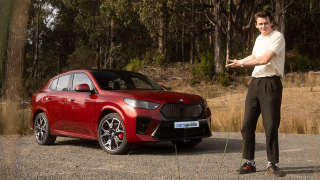
Honda Civic Hybrid 2004 review
- Honda Civic
- Honda Civic 2004
- Honda Civic Reviews
- Honda Reviews
- Honda Sedan Range
- Sedan
- Honda
- EV
- Green Cars

Welcome to the hi-tech world of Honda's Civic Hybrid, a rare model which may look similar to other Civic sedans on the road but is much more clever.
Its thirst, or lack of it, is the Civic Hybrid's claim to fame. Now that we're growing accustomed to seeing $1-plus signs at servos, there is a lot to like in a car which, even when you're driving with no thought of economy, averages 5.6 litres per 100km (50mpg).
That was with four adults on board most of the time, dealing with peak-hour traffic, cruising as fast as the law will allow.
And despite this car's sophisticated powerplant, it is happy with standard unleaded, and obviously not too much of that.
The helpful Hybrid does so well because instead of a normal Civic's 1.7 litre engine, it has a 1.3 litre unit (borrowed from the much smaller Jazz hatchback), boosted by an electric motor. Energy goes back and forth when needed.
A stack of batteries hide behind the back seat, but there is no need to plug it in to be recharged. That's done by energy from the brakes and momentum whenever the car slows.
Stop at a traffic light in the Civic Hybrid and everything goes eerily quiet: The engine has switched itself off to conserve fuel, but re-starts automatically when you put your foot down to drive away again.
It reacts almost instantly, with just a moment's pause – a stop-start trick that impresses passengers every time.
Otherwise, there is not much on the surface to give a clue to the Civic Hybrid's brilliance.
Its interior is straightforward, except for an extra dial on the instrument panel with lots of busily-moving graphs which show whether the "motor assist" system is indeed assisting the petrol engine – meaning the electric motor is kicking in– or is being recharged.
The Civic Hybrid has none of the gee-whiz, look-at-me factor of its only rival, the Toyota Prius. The Prius (much dearer, but using even less fuel) comes with a space-age look to match the Tomorrowland technology built into these petrol misers.
In contrast, Honda's green machine looks like an everyday Civic, hiding its cleverness behind a conservative exterior.
Only the keenest of carspotters will notice the small "Hybrid" badge on the tail, modest spoiler on the boot lid, different-design alloy wheels and front bumper.
The Hybrid is $3000 more than a normal Civic sedan, but is better equipped – with side airbags, for example – and offers fuel savings which would pay off eventually if it was driven far enough, or the price of petrol climbed high enough.
The official fuel numbers suggest the Hybrid would use about two-thirds the fuel of a regular petrol-engined Civic GLi. That sounds like a significant saving, but it still would take many years for the Hybrid owner to get ahead, cost-wise.
In the meantime, they should get some warm feeling of satisfaction from driving one of the most efficient cars on the road, with almost no sacrifices.
Well, it does lose the convenience of a fold-down back seat, and the boot is smaller because of the battery pack. Also, the Hybrid's spare tyre is the last-resort temporary variety.
Pulling up a long, steep hill, being asked to accelerate to 100km/h against gravity, the modest petrol engine starts to sound rather busy, but it never protests. It is a Honda, after all.
Instead of a normal automatic gearbox, the Hybrid has a continuously variable transmission. This helps save fuel, and makes for seamless acceleration. It works fine, just like everything else in the Hybrid.
$4,999 - $6,999
Based on 5 car listings in the last 6 months
$4,999 - $6,999
Based on 5 car listings in the last 6 months







